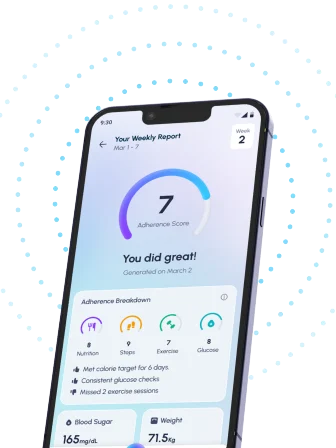Table of Contents
- Vascular Rings and Diabetes: Understanding the Complex Link
- How Vascular Rings Affect Blood Sugar Control in Diabetics?
- Vascular Ring Symptoms: Recognizing the Signs in Diabetic Patients
- Living with Diabetes and a Vascular Ring: A Comprehensive Guide
- Diabetes Management Strategies for Individuals with Vascular Rings
- Frequently Asked Questions
- References
Living with diabetes presents a unique set of challenges, and sometimes, those challenges extend beyond the expected. Did you know that certain vascular anomalies can significantly impact your diabetes management? This blog post delves into Understanding Vascular Rings and Their Impact on Diabetes, exploring how these rare conditions can affect blood flow and overall health. We’ll discuss the connection between vascular rings, often undiagnosed, and complications associated with diabetes, providing you with crucial information to better understand your health. Learning about these potential complications can empower you to advocate for yourself and maintain optimal well-being. Let’s explore this important topic together.
Vascular Rings and Diabetes: Understanding the Complex Link
Diabetes significantly impacts cardiovascular health, and understanding this connection is crucial, particularly in Indian and tropical countries where diabetes prevalence is high. While not directly causing vascular rings, diabetes can exacerbate existing conditions and increase the risk of complications. Vascular rings, congenital abnormalities affecting the blood vessels around the trachea and esophagus, can already present breathing and swallowing difficulties. The added stress of diabetes, especially uncontrolled blood sugar levels, can worsen these issues. High blood glucose contributes to inflammation and damage throughout the body, including the blood vessels. This inflammation can further constrict already compromised airways in individuals with vascular rings, potentially leading to more severe respiratory problems.
The Impact of Diabetic Nephropathy
The link between diabetes and vascular complications is further underscored by the high incidence of diabetic nephropathy. Nearly 30% of people with diabetes develop this kidney disease, which involves damage to the blood vessels in the kidneys. This highlights the systemic impact of diabetes on the vascular system. The compromised blood vessel integrity associated with diabetes can worsen the effects of vascular rings, impacting overall health and quality of life. To better understand how diabetes affects the vascular system, read more about How Does Diabetes Affect Blood Flow?. In tropical climates, where infections and other health challenges are more prevalent, this combined effect can be particularly severe.
Seeking Expert Care in India and Tropical Regions
Early diagnosis and management are vital for individuals with both diabetes and vascular rings. Regular check-ups with specialists, including cardiologists and pulmonologists, are essential for monitoring and managing potential complications. Prompt treatment of diabetic complications, including maintaining optimal blood sugar levels, can significantly reduce the risk of further vascular damage. In India and other tropical countries, access to specialized care might be limited, emphasizing the importance of proactive health management and seeking expert advice at the earliest sign of complications. The connection between diabetes and other organ complications, such as The Link Between Diabetes and Fatty Liver, further highlights the importance of comprehensive care.
How Vascular Rings Affect Blood Sugar Control in Diabetics?
Vascular rings, a rare congenital condition affecting blood vessels around the trachea and esophagus, can indirectly impact blood sugar control in individuals with diabetes, particularly in regions like India and other tropical countries where access to specialized healthcare might be limited. While not a direct cause of diabetes, the physiological consequences of vascular rings can complicate diabetes management.
The Interplay of Vascular Rings and Blood Sugar
The compression of the trachea and esophagus caused by vascular rings can lead to difficulties in breathing and swallowing. These difficulties can indirectly affect blood sugar levels. For instance, compromised breathing can lead to stress and poor sleep, both known to negatively impact glucose regulation. Moreover, difficulty swallowing can disrupt meal timing and consistency, making it challenging to maintain stable blood sugar levels, especially crucial for diabetics aiming for blood sugar levels below 140/90 mmHg, or even below 130/80 mmHg as per some recommendations. This struggle with consistent eating patterns is amplified in regions with limited access to specialized dietary advice or modified food options. Managing these complications effectively is crucial, and understanding the potential link between cardiovascular issues and diabetes, such as those discussed in Does Diabetes Cause Tachycardia?, can be beneficial.
Managing Diabetes with Vascular Rings in Tropical Climates
Managing diabetes alongside vascular rings requires a multi-faceted approach, especially crucial in hot and humid climates prevalent in many tropical nations. The added stress of heat and humidity can further challenge glucose control. Therefore, individuals with both conditions need close monitoring of their blood sugar levels and adherence to their prescribed medication regimen. Regular consultations with both a diabetologist and a cardiothoracic surgeon are vital for tailored management. Seeking early diagnosis and treatment of vascular rings is paramount to minimize complications and improve the overall quality of life. In India and other tropical countries, proactive healthcare seeking and awareness campaigns targeting these rare conditions can significantly enhance the well-being of affected individuals. Early intervention is key to mitigating the indirect impact of vascular rings on diabetes management. Remember that managing other health conditions alongside diabetes is vital. For instance, learn more about How to Manage Cholesterol Levels with Diabetes? to better understand the holistic approach to diabetes care.
Vascular Ring Symptoms: Recognizing the Signs in Diabetic Patients
Understanding the Challenges in Diagnosis
Diabetic patients often face unique challenges in early diagnosis, particularly in resource-constrained regions of India and other tropical countries. This is compounded by the fact that a staggering 50% of diabetes cases worldwide remain undiagnosed, as highlighted by the International Diabetes Federation. Early detection of vascular complications is crucial, and vascular rings, while not directly caused by diabetes, can significantly exacerbate existing diabetic conditions. Recognizing symptoms early is therefore paramount to effective management.
Common Symptoms to Watch For
Symptoms associated with vascular rings can be subtle and easily overlooked, especially in individuals already managing diabetes. Shortness of breath, particularly during exertion, is a key indicator. Wheezing, a persistent cough, and difficulty swallowing (dysphagia) are other common signs. In some cases, chest pain may also manifest. It’s important to note that these symptoms can overlap with other diabetic complications, making accurate diagnosis challenging. Therefore, vigilance and timely medical consultation are crucial. For more information on early detection of diabetes, you might find our article on 10 Early Signs and Symptoms of Diabetes? helpful.
Seeking Help in India and Tropical Regions
For patients in India and other tropical countries, access to advanced diagnostic tools might be limited. However, a thorough medical history, including a detailed account of symptoms, coupled with a physical examination, can often provide important clues. Don’t hesitate to seek medical attention if you experience any of these symptoms, especially if you have a pre-existing diabetic condition. Early intervention is key to improving patient outcomes and managing the combined impact of diabetes and vascular ring anomalies. Early diagnosis can significantly impact the quality of life for those affected. Remember that managing diabetes effectively also includes protecting your vision; read our article on How to Protect Your Vision with Diabetes: Essential Eye Care Tips for valuable insights.
Living with Diabetes and a Vascular Ring: A Comprehensive Guide
Living with diabetes presents numerous challenges, and the presence of a vascular ring can significantly complicate matters. Understanding the interplay between these two conditions is crucial for effective management, especially in populations prevalent in Indian and tropical countries. A significant portion of the global diabetic population, 61% of whom are aged between 20-64 years, as highlighted by the International Diabetes Federation, are in their most productive years, making effective management vital for maintaining quality of life. This is further compounded by the fact that 39% are aged 65+, a group often facing additional health complexities. The challenges faced by older adults with diabetes are further explored in our article, Managing Diabetes as You Age: Challenges and Solutions.
Understanding Vascular Rings and Their Impact
Vascular rings are congenital anomalies affecting the blood vessels around the trachea and esophagus. They can cause various symptoms, including breathing difficulties, swallowing problems (dysphagia), and recurrent respiratory infections. In individuals with diabetes, these symptoms can be exacerbated by existing conditions like neuropathy and cardiovascular complications. For example, compromised blood flow due to vascular rings might worsen diabetic neuropathy, leading to increased pain and reduced limb function. Furthermore, the added stress on the cardiovascular system can increase the risk of complications like heart failure and stroke, already prevalent risks for people with diabetes.
Managing Diabetes with a Vascular Ring
Effective management requires a multidisciplinary approach. Regular consultations with a cardiologist, pulmonologist, and diabetologist are vital. Close monitoring of blood sugar levels, blood pressure, and cholesterol is essential. Lifestyle modifications like a balanced diet, regular exercise (adapted to individual abilities), and stress management techniques are crucial. In tropical and Indian contexts, particular attention should be paid to hydration and heat management, as these factors can influence both diabetes and vascular ring symptoms. Planning travel while managing diabetes requires careful consideration, as highlighted in our article Traveling with Diabetes: Essential Tips for a Safe & Healthy Journey.
Seeking Help in India and Tropical Countries
If you live in India or a tropical country and are diagnosed with both diabetes and a vascular ring, it’s crucial to seek specialized care. Consult with healthcare professionals experienced in managing both conditions, and actively participate in your treatment plan. Early intervention and comprehensive management can significantly improve quality of life and reduce long-term complications. Remember, proactive management is key to thriving despite these challenges.
Diabetes Management Strategies for Individuals with Vascular Rings
Understanding the Interplay of Vascular Rings and Diabetes in Tropical Climates
Individuals with vascular rings face unique challenges in managing diabetes, particularly in hot and humid climates prevalent across many Indian and tropical countries. The added strain on the cardiovascular system, already compromised by the vascular ring, can exacerbate the risks associated with diabetes. Research highlights the significantly increased mortality risk among smokers with diabetes due to cardiovascular complications; this risk is amplified in the presence of a vascular ring. Therefore, proactive and tailored management strategies are crucial.
Prioritizing Cardiovascular Health
Managing diabetes effectively in this population requires a holistic approach prioritizing cardiovascular health. This includes strict blood sugar control to minimize damage to blood vessels. Regular monitoring of blood pressure and cholesterol levels is also paramount, as vascular rings can further complicate these conditions. Lifestyle modifications are critical, especially in tropical settings where heat and humidity can increase stress on the cardiovascular system. This includes adopting a balanced diet rich in fruits, vegetables, and whole grains, while limiting processed foods, saturated fats, and sodium. Regular, moderate exercise, tailored to individual capabilities, is essential. For more detailed tips, see our guide on 10 Proven Tips for Effective Diabetes Management.
Seeking Specialized Care
Access to specialized care is crucial for individuals with both diabetes and vascular rings. Consultations with cardiologists and diabetologists experienced in managing complex cases are highly recommended. These specialists can provide personalized treatment plans, considering the unique challenges posed by the vascular ring. In many Indian and tropical countries, access to such specialized care might be limited; proactive steps to locate appropriate medical professionals are crucial for successful management. Furthermore, open communication with healthcare providers is key to addressing any concerns and ensuring optimal management of both conditions. Regular check-ups and adherence to prescribed medications are vital in preventing complications. Avoiding 5 Common Mistakes People Make in Managing Diabetes is also essential for successful long-term management.
Frequently Asked Questions on Vascular Rings & Diabetes
Q1. How does diabetes affect people with vascular rings?
Diabetes worsens vascular inflammation and damage, leading to more severe breathing and swallowing problems for those with vascular rings. Poorly controlled blood sugar exacerbates the condition.
Q2. What is the impact of diabetic nephropathy on vascular rings?
Diabetic nephropathy, a kidney complication affecting about 30% of diabetics, further increases the systemic vascular problems associated with vascular rings, making the condition even more challenging.
Q3. What kind of medical care is needed for managing diabetes and vascular rings together?
Managing both conditions requires a team approach, including cardiologists and pulmonologists. This is especially important in areas with limited access to specialized care.
Q4. What are the key steps to managing diabetes and reducing complications from vascular rings?
Early diagnosis of both diabetes and vascular rings is crucial. Maintaining good blood sugar control, making healthy lifestyle changes, and seeking prompt medical attention for symptoms are vital.
Q5. What symptoms should prompt immediate medical attention in people with diabetes and suspected vascular rings?
Symptoms like shortness of breath, wheezing, difficulty swallowing (dysphagia), and chest pain warrant immediate medical attention. Don’t delay seeking professional help if you experience these.
References
- A Practical Guide to Integrated Type 2 Diabetes Care: https://www.hse.ie/eng/services/list/2/primarycare/east-coast-diabetes-service/management-of-type-2-diabetes/diabetes-and-pregnancy/icgp-guide-to-integrated-type-2.pdf
- What is Diabetes: https://www.medschool.lsuhsc.edu/genetics/docs/DIABETES.pdf




